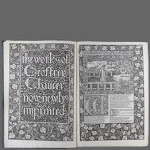
My first museum experience took place on Saturday, November 8th 2008, at the Wadsworth Athenaeum in Hartford, Connecticut. This was a very exciting place for both my daughter and I to visit, since we had never been there before. Upon arriving at the museum, I was amazed at the size and the architecture of the building, which is in the shape of a gothic style castle. It felt very mystical and exhilarating, as if I was walking into the pages of an Arthurian romance novel.
Once we entered the museum, we were greeted by a very friendly museum staff member, who later turned out to be our docent. We were lucky enough to have had arrived when we did, or we would have missed that afternoon’s tour. The subject/focus of the tour was “a search for an identity in early American artwork.” Our tour started out in the main lobby, with a brief introduction about the museum. Next, we viewed several paintings from the past three-hundred years, from the late 1700’s up until the early 1930’s. It was amazing to see how the artists from these different time periods were able to capture the spirit and essence of American life and culture.
One of the first things I learned was that the Wadsworth is the oldest, continually operating museum in the country. It was built in 1842, by a man named Daniel Wadsworth, who was the son of a wealthy Connecticut merchant. He had started his collection in the early 19th century, with artwork ranging from Renaissance paintings to modern American master pieces. Also, this institution originally included additional Neo-Gothic buildings, such as the Connecticut Historical Society and the Hartford Public Library. Today, it houses over 50, 000 works of art in both permanent collections and exhibitions.[1]
One of the paintings that impressed me the most was the “The Declaration of Independence” by John Trumball, which I will describe in more detail throughout the rest of this paper. It was commissioned in 1817 by the United States Senate and was later hung in the Rotunda at the U.S. Capital in 1826. The purpose of this work was to commemorate this momentous historical event in our country’s history, when our founding fathers signed a document that would give Americans both personal and religious freedom. According to the Yale University Art Galley, Thomas Jefferson is thought to have given Trumball a first hand account of what happened on that historic day.[2] Although the scene depicted is not quite accurate (since not all members of the committee were present during the signing), it embodies the entire process that the colonies went through in order to gain independence from England, resulting in the formation of our country, the United States of America. It communicates a message of hope and promise to future generations, that all people have the right to live their lives the way they see fit, regardless of race or social status.
Trumball was born on June 6, 1756 in Lebanon, Connecticut and died in 1843. He was born into a wealthy and politically important family; his father was the Governor of Connecticut for several years.[3] He attended Harvard at the age of fifteen and it was here that he decided to pursue his love of drawing and painting.[4] After serving as an aide to George Washington in the American Revolution, he went on to study with Benjamin West, who is considered to be one of the most influential artists and teachers of art during the 18th and 19th centuries. [5] It was from his mentor, as well as his first-hand eyewitness accounts of important battles in the war, that lead this artist to cultivate his talent for historical painting.[6] John Trumball went on to become a very famous and accomplished artist, despite the fact that he lost sight in one of his eyes.[7]
In terms of the actual painting itself, the first thing I noticed was its size. The enormity of the piece helps to convey the magnitude of the event taking place on the canvas. One feels as if they are actually sitting in the Assembly Room in Independence Hall, while Thomas Jefferson, Benjamin Franklin, John Adams, Robert R. Livingston, and Roger Sherman presented the signed Declaration of Independence to Congress.[8]
What is also so striking about this painting is the fact that each of the forty-eight individuals is unique and depicts a real person who lived during this time period and was involved in this important process. The materials the artist used were oil paints and a canvas. His use of light helps illuminate the subjects in the painting, as well as draws attention to the colors and style of the men’s clothing, which is accurate for both the time period and their social class. The amount of detail involved in drawing and painting each person is amazing, given the fact that each one is drawn almost true to form, right down to the body-type and stature. It is interesting to note that several people from my tour group, including myself, were able to identify some of the men just by looking at the painting, which is a testimony to Trumball’s great talent and craftsmanship.
[1] http://www.wadsworthathenauem.org/.
[2] http://artgallery.yale.edu /pages/collectionpopups1pc_amerps/details01.html.
[3] http://www.wikipedia.org/.
[4] Ibid.
[5] http://www.artcyclopedia.com/
[6] Ibid.
[7] www.wikipedia.org
[8] http://www.artcyclopedia.com/






2 comments:
Linda
I visited this museum too. It was the first one. Everything seems to be coming together. Did you know that John Trumbull donated over 100 paintings to the Yale University Art Gallery when the musueum opened. I just found that out when I did my paper on that museum.
KJ-
Thanks for that bit of information. I had no idea he was so generous, hehe! Trumball was a very gifted artist. Actually, this was my first museum visit too. Did you take a guided tour? My daughter and I did. We both found it to be very helpful and intellectually stimulating.
Post a Comment